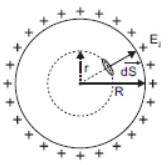Ask questions which are clear, concise and easy to understand.
Ask QuestionPosted by Ajitha Kumari 2 years, 11 months ago
- 3 answers
Anjan Karthi 2 years, 11 months ago
Posted by Arnav Thakur 2 years, 11 months ago
- 0 answers
Posted by Vishal Sharma 2 years, 11 months ago
- 0 answers
Posted by Maahnoor Quraishi 2 years, 11 months ago
- 2 answers
Preeti Dabral 2 years, 11 months ago
- The electric flux through an area is defined as the electric field multiplied by the area of the surface projected on a plane, perpendicular to the field. Its S.I. unit is voltmeter (Vm) or Newton metre square per coulomb (Nm2 C-1). The given statement is justified because while measuring the flux, the surface area is more important than its volume on its size.
- Electric field inside the shell:

The charge resides on the surface of a conductor. Thus, a hollow charged conductor is equivalent to a charged spherical shell. Let's consider a spherical Gaussian surface of radius (r < R). If E is the electric field inside the shell, then by symmetry electric field strength has the same magnitude Ei on the Gaussian surface and is directed radially outward.
Electric flux through the Gaussian surface is given by,
{tex}=\int_{s} \vec{E}_{i} \cdot d \vec{S}{/tex}
{tex}=\int E_{i} d S \cos 0=E_{i} .4 \pi r^{2}{/tex}
Now, Gaussian surface is inside the given charged shell, so charge enclosed by Gaussian surface is zero.
Therefore, using Gauss's theorem, we have
{tex}\int_{S} \vec{E}_{i} \cdot d \vec{S}=\frac{1}{\epsilon_{0}} \times \text { charge enclosed }{/tex}
{tex}\Rightarrow E_{i} \cdot 4 \pi r^{2}=\frac{1}{\epsilon_{0}} \times 0{/tex}
{tex}\Rightarrow{/tex} Ei = 0
Thus, electric field at each point inside a charged thin spherical shell is zero.
Mayank Chauhan 2 years, 11 months ago
Posted by Aayush Singh 2 years, 11 months ago
- 1 answers
Preeti Dabral 2 years, 11 months ago
r=√(2mqV) / qB
as given alpha particle q=2e=2×1.6×10^-19
V=10^4V
m=6.4×10^-27kg
B=2×10^-3T
r=√(2 × 6.4×10^-27 × 2× 1.6×10^-19 × 10^4) /1.6×10^-19 × 2×10^-3
=√(4096×10^-44) / 64 × 10^-23
=(64 × 10^-22) / (64 × 10^-23)
=10
therefore radius is 10m
Posted by Muskan Khatun 2 years, 11 months ago
- 1 answers
Kashu Verma 2 years, 11 months ago
Posted by Manish Singh 2 years, 11 months ago
- 1 answers
Posted by Deepanshu Goyal 2 years, 11 months ago
- 1 answers
Anjan Karthi 2 years, 11 months ago
Posted by Shivansh Devaliya 2 years, 11 months ago
- 1 answers
Nidhi Rathod 2 years, 11 months ago
Posted by Rana Pratap Singh Singh 2 years, 11 months ago
- 1 answers
Kashu Verma 2 years, 11 months ago
Posted by Gunjan 2 years, 11 months ago
- 1 answers
Posted by Niharika Singh 2 years, 11 months ago
- 0 answers
Posted by Jatin Grewal 3 years ago
- 1 answers
Anjan Karthi 2 years, 11 months ago
Posted by Akriti Singh 3 years ago
- 0 answers
Posted by Aryan Singh 3 years ago
- 2 answers
Preeti Dabral 3 years ago
electron charge, (symbol e), fundamental physical constant expressing the naturally occurring unit of electric charge, equal to 1.602176634 × 10−19 coulomb.
Posted by Harleen Kaur 3 years ago
- 1 answers
Preeti Dabral 3 years ago
Based on the circuit given in the figure , we have three known resistance's R1,R2,R3 and an unknown variable resistor RX, a source of voltage, and a sensitive ammeter.
Kirchhoff's first rule is applied to find the currents in junctions B and D:
I3−Ix+Ig=0
I1−I2−Ig=0
Now Kirchoff's second rule is used to find the voltage in the loops ABD and BCD:
I3.R3−Ig.Rg−I1.R1=0
Ix.RX−I2.R2+Ig.Rg=0
The bridge is balanced and Ig = 0, so the second set of equations can be rewritten as:
I3.R3=I1.R1
Ix.RX=I2.R2
From first rule of Kirchoff.
I3=Ix
I1=I2
{tex}\begin{aligned} & \frac{\mathrm{I}_3 \cdot \mathrm{R}_3}{\mathrm{I}_{\mathrm{n}} \cdot \mathrm{R}_{\mathrm{X}}}=\frac{\mathrm{I}_1 \cdot \mathrm{R}_1}{\mathrm{I}_2 \cdot \mathrm{R}_2} \\ & \frac{\mathrm{R}_1}{\mathrm{R}_2}=\frac{\mathrm{R}_3}{\mathrm{R}_{\mathrm{x}}} \end{aligned}{/tex}
Posted by Rachna Yadav 3 years ago
- 3 answers
Preeti Dabral 3 years ago
electric potential, the amount of work needed to move a unit charge from a reference point to a specific point against an electric field. Typically, the reference point is Earth, although any point beyond the influence of the electric field charge can be used.
Yash Thakkar 3 years ago
Posted by Om Singh 3 years ago
- 2 answers
Anjan Karthi 3 years ago
Posted by Aarzoo Saini 3 years ago
- 1 answers
Preeti Dabral 3 years ago
A half-wave rectifier converts an AC signal to DC by passing either the negative or positive half-cycle of the waveform and blocking the other. Half-wave rectifiers can be easily constructed using only one diode, but are less efficient than full-wave rectifiers.
Posted by Vans Sroha 3 years ago
- 1 answers
Posted by Mohit Sahu 3 years ago
- 2 answers
Anjan Karthi 2 years, 11 months ago
Posted by Shiv Otti 3 years ago
- 0 answers
Posted by Ramnarayan Godara 3 years ago
- 1 answers
Posted by Amit Sharma 3 years ago
- 1 answers
Preeti Dabral 3 years ago
12 cm
As the charge q, can be equilibrium present only when its is kept in between charges +9e and +e, correct answer is x=12 cm.
Posted by Aman Deep 3 years ago
- 1 answers
Amit Sharma 3 years ago
Posted by Mohamed Farhan 3 years ago
- 4 answers
Posted by Devanshu Gautam Master 3 years ago
- 5 answers

myCBSEguide
Trusted by 1 Crore+ Students

Test Generator
Create papers online. It's FREE.

CUET Mock Tests
75,000+ questions to practice only on myCBSEguide app
 myCBSEguide
myCBSEguide
Anjan Karthi 2 years, 11 months ago
1Thank You